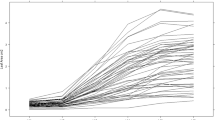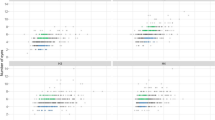Abstract
The production of attractive, uniform true potato seed (TPS) progenies was investigated. Four breeding schemes were compared: intercrossing tetraploid cultivars (cv x cv); doubled dihaploids x cultivars (ddh x cv); cultivars x diploid unreduced-gamete producers (cv x FDR) and doubled dihaploids x diploid unreduced-gamete producers (ddh x FDR). Fifty three progenies and five clones were grown in a glasshouse in a randomised complete block design with three replicates of 25 plants per progeny and clone. Each plant's tubers were counted and the colour, shape, quality of skin finish, flesh colour, and commencai attractiveness (which includes yield) recorded. The most uniform progenies were also selected by visual comparison with the clones. For mean attractiveness, differences (P < 0.001) between breeding schemes and between progenies within breeding schemes were detected. The cv x cv and cv x FDR progenies were more attractive than clonal controls. There were significant additive and non-additive effects for attractiveness in all breeding schemes except cv x FDR. There were between-progeny differences (P < 0.001) for uniformity for all characters. Progenies uniform for one character could be variable for other traits. Breeding schemes gave different levels of uniformity (P < 0.001) for all characters except shape and flesh colour, but none gave low levels of variation for all traits. Doubled-dihaploid parents increased the variation in progenies. There were uniformity differences (P < 0.001) between progenies within breeding schemes for all characters. Evidence of additive and nonadditive genetic variation for uniformity in all traits was detected. In each breeding scheme, parents with good general combining ability (GCA) for uniformity in several characters were identified. Visually selected uniform progenies had parents with good GCAs for uniformity in a range of traits and high specific combining abilities (SCAs) for several traits. A desynaptic first-division restitution (FDR) clone and a male-sterile doubled-dihaploid clone had the best GCAs for tuber uniformity in TPS progenies. Achieving multitrait uniformity in TPS is problematic but may be aided by the selection of parents with GCAs for uniformity coupled with progeny testing to allow for non-additive effects.
Similar content being viewed by others
References
Anon (1983) True potato seed. An alternative method of potato production. CIP Training Series. Training and Communications Department, International Potato Centre, Lima, Peru
Atlin G (1985) Farmer maintenance of TPS varieties. In: Report of a Planning Conference on ‘Innovative methods for propagating potatoes’, Lima, Peru, December 1984, pp 39–62
Brown J, Caligari PDS, Mackay GR, Swan GEL(1987) The efficiency of visual selection in early generations of a potato breeding programme. Ann Appl Biol 110:357–363
Brown J, Caligari PDS, Dale MFB, Swan GEL, Mackay GR (1988) The use of cross prediction methods in a practical potato breeding programme. Theor Appl Genet 76:33–38
Buso JA, Peloquin SJ (1988) Comparisons of families from 4x × 4x crosses in Brazil. Am Potato J 65:472
Clulow SA, Bradshaw JE (1994) Glasshouse-based selection to identify agronomically adapted, uniform true potato seed (TPS) progenies. Ann Appl Biol 124:519–529
Concilio L, Peloquin SJ (1987) Tuber yield of true breeding potato seed families from different breeding schemes. Am Potato J 64:81–85
Daniel W W (1978) Applied nonparametric statistics. Haughton Mifflin Company, London
De, Maine MJ, Jervis L (1989) The use of dihaploids in increasing the homozygosity of tetraploid potatoes. Euphytica 44:37–42
Griffing B (1956) The concept of general and specific combining ability in relation to diallel crossing systems. Aust J Biol Sci 9: 463–493
Hermsen JGTh (1983) New approaches to breeding for the potato in the year 2000. In:Hooker WJ (ed) Research for the potato in the year 2000. International Potato Centre, Lima, Peru, pp 29–32
Iwanaga M (1984) Discovery of a synaptic mutant in potato haploids and its usefulness for potato breeding. Theor Appl Genet 68:87–93
Jacobsen (1978) Doubling dihaploid potato clones via leaf tissue culture. Z Plfanzenzucht 80:80–82
Jakubiec J (1987) Variability of F1 progeny derived from inter-ploidy (4x x 2x) crossing. In: Jellis GJ, Richardson DE (eds) The production of new potato varieties: technological advances. Cambridge University Press, Cambridge, UK, pp 218–221
Jongedijk E, Ramanna MS (1989) Synaptic mutants in potato, Solanum tuberosum L. II. Concurrent reduction of chiasma frequencies in male and female meiosis of ds — 1 (desynapsis) mutants. Genome 32:1054–1062
Jongedijk E, Hutten RCB, van der Wolk JMASA, Schuurmans Stekhoven SIJ (1991) Synaptic mutants in potato, Solanum tuberosum L. III. Effect of the Ds — 1/ds 1 locus (desynapsis) on genetic recombination in male and female meiosis. Genome 34:121–130
Kidane-Mariam HM, Arndt GC, Macaso-Khwaja AC, Peloquin SJ (1985) Comparisons between 4x x 2x hybrid and open-pollinated true potato seed families. Potato Res 28:35–42
Macaso-Khwaja AC, Peloquin SJ (1983) True potato seed families from different breeding schemes. Am Potato J 60:814–815
Mok DWS, Peloquin SJ (1975) Breeding value of 2n pollen (diplandroids) in tetraploid x diploid crosses in potatoes. Theor Appl Genet 46:307–314
Ortiz R, Iwanaga M, Mendoza H (1988) Combining ability and parental effects in 4x × 2x crosses for potato breeding. Potato Res 31:643–650
Peloquin SJ (1979) Breeding method for achieving phenotypic uniformity. In: International Potato Centre Report of the Planning Conference on the production of potatoes from true seed. Manila, Philippines, pp 151–155
Peloquin SJ, Yerk GL, Werner JE, Darmo E (1989) Potato breeding with haploids and 2n gametes. Genome 31:1000–1004
Ramanna MS (1979) A re-examination of the mechanisms of 2n gamete formation in potato and its implications for breeding. Eupytica 28:537–561
Ross H (1986) Potato breeding problems and perspectives. Verlag Paul Parey, Berlin Hamburg, pp 61–63.
Rowell AB, Ewing EE, Plaisted RL (1986) General combining ability of neo-tuberosum for potato production from true seed. Am Potato J 63:141–153
Thompson PG (1982) A comparison of different levels of inbreeding and genetic heterogeneity in potatoes propagated by true seed (TPS). Hort Science 17:154
Thompson PG, Mendoza HA (1984) Genetic variance estimates in a heterogenous potato population propagated from true seed (TPS). Am Potato J 61:697–702
Author information
Authors and Affiliations
Additional information
Communicated by G. Wenzel
Rights and permissions
About this article
Cite this article
Clulow, S.A., McNicoll, J. & Bradshaw, J.E. Producing commercially attractive, uniform true potato seed progenies: the influence of breeding scheme and parental genotype. Theoret. Appl. Genetics 90, 519–525 (1995). https://doi.org/10.1007/BF00221998
Received:
Accepted:
Issue Date:
DOI: https://doi.org/10.1007/BF00221998




